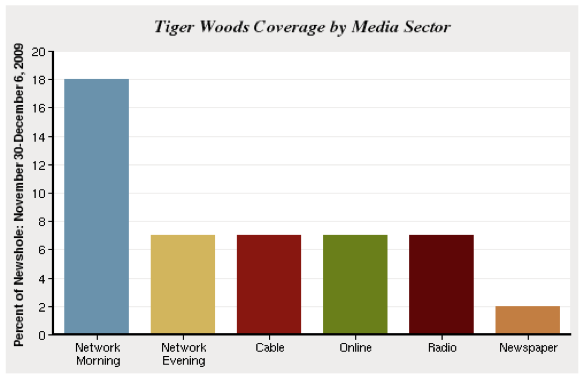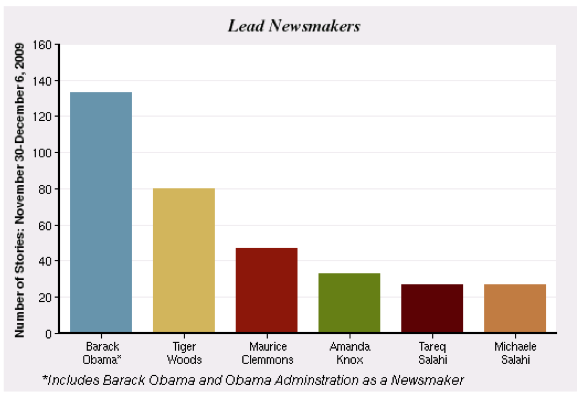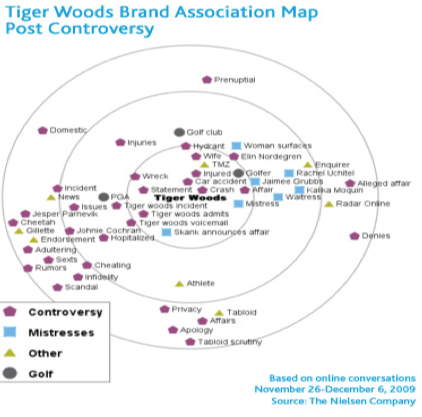From Elon Journal of Undergraduate Research in Communications VOL. 3 NO. 2Crisis Management and Sports in the Age of Social Media: A Case Study Analysis of the Tiger Woods ScandalIV. ConclusionCrises can arise at all times, in all industries. But no industry sees a more disproportionate share of media attention than sports. The growing interest of the American people and the development of social media have created an environment that disseminates rapidly information surrounding athlete scandal and extends its discussion. It has increased the need for pre-crisis planning and post-crisis responses. In 2009, Tiger Woods experienced it firsthand, as stories of alleged mistresses and a furious wife made their way to the media. Woods' PR staff relied primarily on mortification strategies to manage the crisis, accepting blame and apologizing to his wife, family, and fans whenever he spoke. Though it is highly unlikely Woods' image returns to what it used to be, social media research indicates conversations regarding the professional golfer are slowly returning to the discussion of his game. Public opinion of Woods has improved, since the break of the scandal; and though the public disapproved of his behavior and occasionally the way the crisis was handled, the mortification strategies used were mildly effective. One can conclude that atonement helps humanize once larger-than-life athletes. But ultimately, his success on the course will have the biggest impact on how people regard Tiger Woods. AcknowledgmentsThis author is thankful to Dr. Michael Frontani at Elon University for his supervision and advice, without which the article could not be published. The author also appreciates numerous reviewers who have helped revise this article. ReferencesAbout Tiger Woods. (n.d.). Retrieved April 19, 2012, from TigerWoods.com website: http://web.tigerwoods. com/aboutTiger/bio Badenhausen, K. (2009, June 17). The world's highest-paid athletes. Retrieved from Forbes website: http://www.forbes.com/2009/06/17/top-earning-athletes-business-sports-top-earning-athletes.html Brown, K., Dickhaus, J., & Long, M. (2012, Spring). LeBrown James and "the decision": An empirical examination of image repair in sports. Journal of Sports Media, 7(1), 149-173. Burnett, J. (2002). Managing business crises: From anticipation to implementation. Westport, CT: Quorum Books. Caywood, C. & Stocker, K. (1997). A strategic approach to crisis management. In The handbook of strategic public relations & integrated communications (pp. 189-203). New York, NY: McGraw-Hill. Coombs, W. T. (2007, October 30). Crisis management and communications. Retrieved from Institute for Public Relations website: http://www.instituteforpr.org/topics/crisismanagement-and-communications/ Cross, M. (2011). Bloggerati, twitterati: How blogs and twitter are transforming popular culture. Santa Barbara, CA: Praeger. Curtin, T., Hayman, D., & Husein, N. (2005). Managing a crisis: A practical guide. New York, NY: Palgrave Macmillan. Davie, W., King, C. R., & Leonard, D. (2010, Fall). A media look at Tiger Woods-two views. Journal of Sports Media, 5(2), 108-115. Fink, S. (1986). Crisis management: Planning for the inevitable. New York, NY: AMACOM. Gottschalk, J. (2002). Crisis management. Jurkowitz, M. (2009, December 8). Surge in Afghanistan coverage: Tiger and Salahis well below war on news agenda. Retrieved from Pew Research Center website: http://pewresearch.org/pubs/1433/newscoverage-afghanistan-surge-tiger woods-salahi Larsen, J. P. & Massey, J. E. (2006). Crisis management in real time: How to successfully plan for and respond to a crisis. Journal of Promotion Management, 12(3/4), 63-97. Len-Rios, M. E. (2010, September). Image repair strategies, local news portrayals and crisis stage: A case study of Duke University's lacrosse team crisis. International Journal of Strategic Communications, 4(4), 267-287. Mitroff, I. (2000). A best practice model: A general framework for crisis management. In Managing crises before they happen (pp. 29-50). Nordegren, E., & Woods, T. (2010, August 23). A statement from Elin Nordegren and Tiger Woods. Retrieved from TigerWoods.com website: http://web.tigerwoods.com/news/article/2010082313818490/release/ Phua, J. (2012, Spring). Use of social networking sites by sports fans: Implications for the creation and maintenance of social capital. Journal of Sports Media, 7(1), 109-132. Reed, S. (2011, Fall). Sports journalists' use of social media and its effects on professionalism. Journal of Sports Media, 6(2). Teitelbaum, S. H. (2010). Athletes who indulge their dark side: Sex, drugs and cover-ups. Santa Barbara, CA: ABC-CLIO. Tiger to give remarks Friday. (2010, February 17). Retrieved from TigerWoods.com website: http://web.tigerwoods.com/news/article/201002178086282/news/ Tiger to return to pro golf at Masters. (2010, March 16). Retrieved from TigerWoods.com. website: http://web.tigerwoods.com/news/article/201003168805154/news/ Web chatter about Tiger Woods begins to shift back towards golf. (2010, March 22). Retrieved from Nielsen Wire website: http://blog.nielsen.com/nielsenwire/online_ mobile/web-chatter-about-tiger-woodsbegins-to-shift-back-towards-golf/ Woods, T. (2009, November 29). Statement from Tiger Woods. Retrieved from TigerWoods.com website: http://web.tigerwoods.com/news/article/200911297726222 /news/ Woods, T. (2009, December 2). Tiger comments on current events. Retrieved from TigerWoods.com website: http://web.tigerwoods.com/news/article/200912027740572/news/ Woods, T. (2009, December 11). Tiger Woods taking hiatus from golf. Retrieved from TigerWoods.com website: http://web.tigerwoods.com/news/article/200912117801012/news/ Woods, T. (2010, February 19). Tiger's public statement. Speech presented at PGA Tour TPC Sawgrass Clubhouse, Ponte Vedra Beach, Fla. Woods, T. (2010, April 8). Tiger's Masters press conference: Thursday. Press conference presented at the Augusta National Golf Club, Augusta, Ga. AppendixFigure 1. Tiger Woods' coverage by media sectors. Copyright by Pew Research Center Publications
Figure 2. Lead newsmakers' coverage. Copyright by Pew Research Center Publications
Figure 3. Tiger Woods' brand association map—Post controversy. Copyright by Nielsen Wire.
Figure 4. Tiger Woods' brand association map—Golf back in play. Copyright by Nielsen Wire.
Suggested Reading from Inquiries Journal
Inquiries Journal provides undergraduate and graduate students around the world a platform for the wide dissemination of academic work over a range of core disciplines. Representing the work of students from hundreds of institutions around the globe, Inquiries Journal's large database of academic articles is completely free. Learn more | Blog | Submit Latest in Business & Communications |

























